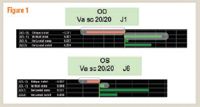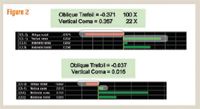Article
Aspheric IOLs, corneal aberrations may combine to enhance pseudoaccommodation, physician says
Aspheric IOLs, in conjunction with certain corneal aberrations, may significantly expand depth of focus, enhancing apparent accommodation. It may possible to define the predictability of a multi-focal cornea in apparent accommodation.

Key Points

Dr. Michelson, associate clinical professor of ophthalmology, University of Alabama School of Medicine, and a practitioner at the Alabama Eye & Cataract Center, Birmingham, said that the incidence of pseudoaccommodation with a monofocal posterior chamber IOL has been reported to be as high as 9%,1 and a significant positive correlation between corneal multifocality and apparent accommodation with monofocal posterior chamber lenses has been found. In fact, trefoil Z3-3 and vertical comas Z3-1 displayed a high correlation with apparent accommodation.2
Also, he noted that in natural accommodation, a tendency exists for increased negative SA and increase in vertical coma.
To address that question, he and his colleagues studied 50 patients with near visual acuity of 20/30 or better who had a monofocal aspheric IOL (SN60WF, Alcon Laboratories) implanted in their eyes.
"The aspheric IOL adds –0.20 µm of negative SA," Dr. Michelson said. "We found that 66% of these patients had some degree of accommodation and could see near at least 20/60 or better."

Dr. Michelson and his colleagues then investigated how corneal coma aberrations might affect apparent accommodation in pseudophakia with an aspheric IOL. They evaluated corneal wavefront differences between eyes with and without apparent pseudoaccommodation using corneal wavefront analysis (Humphrey Atlas, Carl Zeiss Meditec).
The Z3-3 oblique trefoil showed an inverse correlation with logMAR near vision, and the Z3-1 vertical coma showed a direct correlation with logMAR near vision, but neither finding was clinically significant.
Patients who had the best near vision, at 20/25, showed the greatest amount of Z3-1 vertical coma, however.
"When we looked at the relationship between the Z3-3 and the Z3-1, we found a pattern that persisted in these patients," Dr. Michelson said. "One example was a patient in whom both eyes were 20/20 at distance, but the right eye was J1 and the left eye was J6. We found that this patient's vertical coma and oblique trefoil were markedly different: the oblique trefoil was 10 times higher in the right eye, and the vertical coma was 22 times higher in the left." (Figures 1 and 2)
When he and his colleagues looked at the ratio between the Z3-3 and the Z3-1, they found a positive correlation, with a p value of 0.03.
"The question is, is presbyopia correction through negative higher-order SA from an aspheric IOL predictable? Dr. Michelson said. "Does the corneal trefoil, and vertical coma with the positive SA in the cornea, combined with the negative SA in a lens, enhance accommodation to improve amplitude of legibility and depth of focus?"
In a 2006 study, researchers examined whether aspheric IOLs reduce depth of focus and therefore render the pseudophakic eye more vulnerable to errors in defocus. Using adaptive optic simulation, the researchers concluded that removing negative SA actually could reduce depth of focus, and, in addition, that the quality of near vision actually worsens in the absence of other higher-order aberrations including trefoil and coma when correcting only for SA.3
Another study demonstrated that correcting ocular SA improves spatial vision in the best-focus position without compromising the subjective tolerance to defocus.4
"While there are lenticular factors that may affect pseudoaccommodation, including negative SA, increasing power of the lens (IOL) and anterior-posterior shift, I think there are corneal factors that are also going to affect pseudoaccommodation, including the oblique trefoil and the vertical coma," Dr. Michelson said. "Aspheric IOLs, in conjunction with certain corneal aberrations, may significantly expand the depth of focus, enhancing apparent accommodation."
References
1. Nanavaty M, Vasavada A, Patel AS, Raj SM, Desai TH. Analysis of patients with good uncorrected distance and near vision after monofocal intraocular lens implantation. J Cataract Refract Surg. 2006;32:1091-1097.
2. Oshika T, Mimura T, Tanaka S, et al. Apparent accommodation and corneal wavefront aberration in pseudophakic eyes. Invest Ophthalmol Vis Sci. 2002;43:2882-2886.
3. Artal P, Tabernero J. Do aspheric IOLs worsen pseudoaccommodation? Cataract and Refractive Surgery Today. November/December 2006:76-77.
4. Piers P, Fernandez E, Manzanera S, Norrby S, Artal P. Adaptive optics simulation of intraocular lenses with modified spherical aberration. Invest Ophthalmol Vis Sci. 2004;45:4601-4610.
Newsletter
Don’t miss out—get Ophthalmology Times updates on the latest clinical advancements and expert interviews, straight to your inbox.




